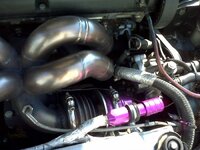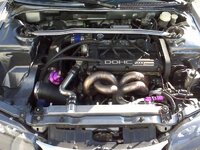dsmcurse
10+ Year Contributor
- 969
- 13
- Aug 14, 2009
-
Pasco,
Washington
hey guys just wanted to get opinions on my crank case ventalation system and share what ive figured out. well, after constantly forgetting to drain my oil catch can i gave up on it and just run my vent hoses to the bottom of my engine bay and have K&N breather filters on the end of each hose.
im just ventin the crap to the atmosphere, but im doin it down low in the engine bay where any oil residue crap would just fling off to the undercaridge of the car and not in the engine bay. i had a nice catch can and experimented with hooking it up to the air filter pipe and what not. i never really like havin the air filter pipe tied into the crankcase pressure system because my turbo was pullin in dirty oil residue air.
i always see the "dipstick spring" mod to hold the dipstick in. it obvious that theres alot of block pressure under high boost. this is why are dipsticks pop out two or three inches after a 30psi power pull. well i figured that dipstick tube would be a great place to vent off some pressure.
i took two dipstick tubes, cut them so they would form a "Y" when welded back together. i cut them in a way that when the stick is in the tube the rubber groment of the top wouldnt poke down inside far enough to block my freeflowin Y shape. i then just hose clamped on a peice of hose that could survive the hottness of being next to the turbo header.
i used to run the block pressure releif off the dipstick tube into the catch can with the two valve cover vents. but like i said the can in my opinion is more trouble than its worth. at the bottom of the dipstick breather hose is a K&N breather filter. the two vents off the top of the valve cover are 5/8" and the dipstick tube thats "y'd" has a 5/8" hose also. this system seems to work the best for me out of all the other combinations ive tried in the past. and my dipstick never ever pops out either and it requires no spring
im just ventin the crap to the atmosphere, but im doin it down low in the engine bay where any oil residue crap would just fling off to the undercaridge of the car and not in the engine bay. i had a nice catch can and experimented with hooking it up to the air filter pipe and what not. i never really like havin the air filter pipe tied into the crankcase pressure system because my turbo was pullin in dirty oil residue air.
i always see the "dipstick spring" mod to hold the dipstick in. it obvious that theres alot of block pressure under high boost. this is why are dipsticks pop out two or three inches after a 30psi power pull. well i figured that dipstick tube would be a great place to vent off some pressure.
i took two dipstick tubes, cut them so they would form a "Y" when welded back together. i cut them in a way that when the stick is in the tube the rubber groment of the top wouldnt poke down inside far enough to block my freeflowin Y shape. i then just hose clamped on a peice of hose that could survive the hottness of being next to the turbo header.
i used to run the block pressure releif off the dipstick tube into the catch can with the two valve cover vents. but like i said the can in my opinion is more trouble than its worth. at the bottom of the dipstick breather hose is a K&N breather filter. the two vents off the top of the valve cover are 5/8" and the dipstick tube thats "y'd" has a 5/8" hose also. this system seems to work the best for me out of all the other combinations ive tried in the past. and my dipstick never ever pops out either and it requires no spring






 @ "catch can master".
@ "catch can master". 













